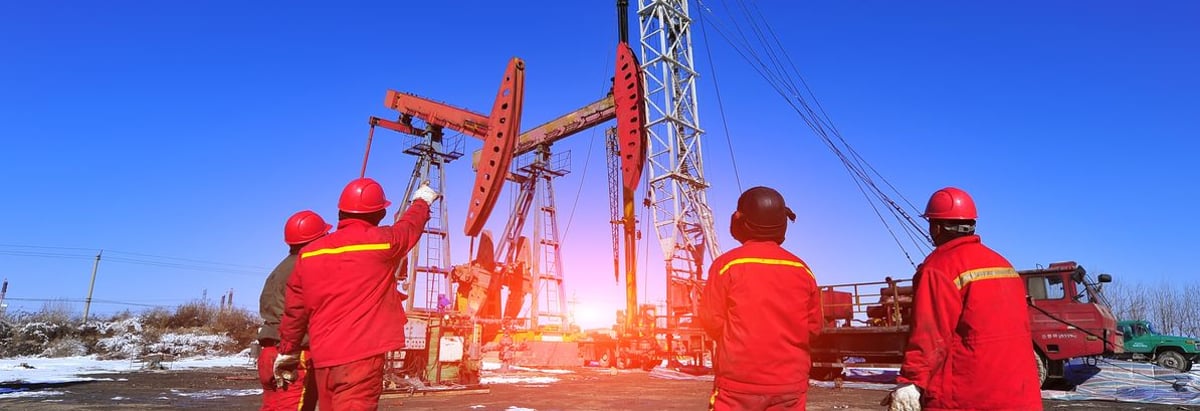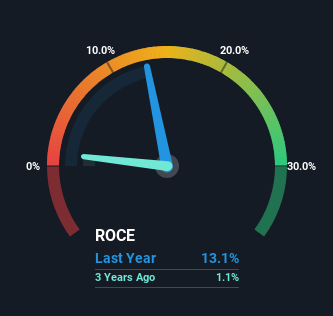- United States
- /
- Energy Services
- /
- NYSE:HP
Helmerich & Payne (NYSE:HP) Is Doing The Right Things To Multiply Its Share Price

There are a few key trends to look for if we want to identify the next multi-bagger. Firstly, we'll want to see a proven return on capital employed (ROCE) that is increasing, and secondly, an expanding base of capital employed. Basically this means that a company has profitable initiatives that it can continue to reinvest in, which is a trait of a compounding machine. So on that note, Helmerich & Payne (NYSE:HP) looks quite promising in regards to its trends of return on capital.
Return On Capital Employed (ROCE): What Is It?
If you haven't worked with ROCE before, it measures the 'return' (pre-tax profit) a company generates from capital employed in its business. The formula for this calculation on Helmerich & Payne is:
Return on Capital Employed = Earnings Before Interest and Tax (EBIT) ÷ (Total Assets - Current Liabilities)
0.13 = US$512m ÷ (US$4.3b - US$433m) (Based on the trailing twelve months to June 2023).
Thus, Helmerich & Payne has an ROCE of 13%. In absolute terms, that's a pretty normal return, and it's somewhat close to the Energy Services industry average of 11%.
Check out our latest analysis for Helmerich & Payne

Above you can see how the current ROCE for Helmerich & Payne compares to its prior returns on capital, but there's only so much you can tell from the past. If you're interested, you can view the analysts predictions in our free report on analyst forecasts for the company.
What Does the ROCE Trend For Helmerich & Payne Tell Us?
We're pretty happy with how the ROCE has been trending at Helmerich & Payne. The figures show that over the last five years, returns on capital have grown by 35,897%. That's not bad because this tells for every dollar invested (capital employed), the company is increasing the amount earned from that dollar. Interestingly, the business may be becoming more efficient because it's applying 34% less capital than it was five years ago. If this trend continues, the business might be getting more efficient but it's shrinking in terms of total assets.
Our Take On Helmerich & Payne's ROCE
In a nutshell, we're pleased to see that Helmerich & Payne has been able to generate higher returns from less capital. And given the stock has remained rather flat over the last five years, there might be an opportunity here if other metrics are strong. That being the case, research into the company's current valuation metrics and future prospects seems fitting.
Before jumping to any conclusions though, we need to know what value we're getting for the current share price. That's where you can check out our FREE intrinsic value estimation that compares the share price and estimated value.
While Helmerich & Payne isn't earning the highest return, check out this free list of companies that are earning high returns on equity with solid balance sheets.
Valuation is complex, but we're here to simplify it.
Discover if Helmerich & Payne might be undervalued or overvalued with our detailed analysis, featuring fair value estimates, potential risks, dividends, insider trades, and its financial condition.
Access Free AnalysisHave feedback on this article? Concerned about the content? Get in touch with us directly. Alternatively, email editorial-team (at) simplywallst.com.
This article by Simply Wall St is general in nature. We provide commentary based on historical data and analyst forecasts only using an unbiased methodology and our articles are not intended to be financial advice. It does not constitute a recommendation to buy or sell any stock, and does not take account of your objectives, or your financial situation. We aim to bring you long-term focused analysis driven by fundamental data. Note that our analysis may not factor in the latest price-sensitive company announcements or qualitative material. Simply Wall St has no position in any stocks mentioned.
About NYSE:HP
Helmerich & Payne
Provides drilling solutions and technologies for oil and gas exploration and production companies.
Undervalued with mediocre balance sheet.
Similar Companies
Market Insights
Community Narratives


